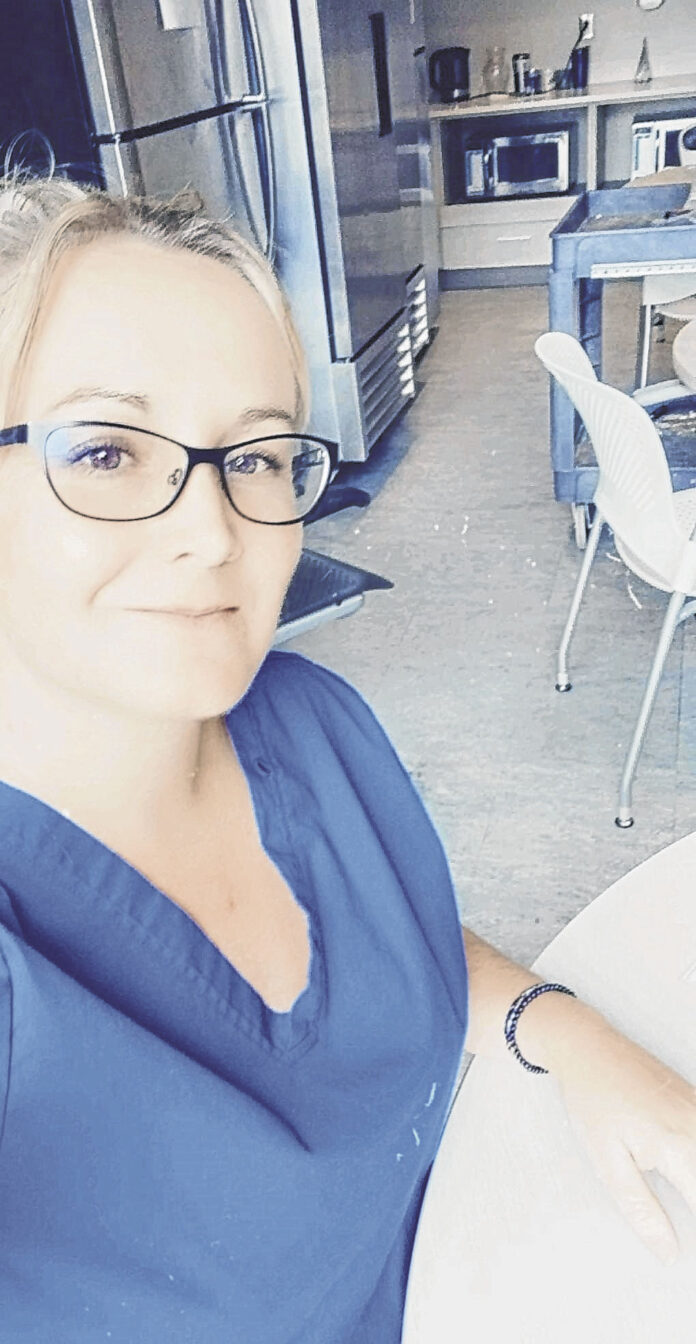For Cassie Bolduc, it all started with what seemed like a sinus infection.
It was the second week of January, and the 40-year-old former clinical nurse specialist at Southern Indiana Nephrology and Hypertension had been helping out as needed at Columbus Regional Hospital’s intensive care unit for about two months as COVID-19 hospitalizations surged.
Bolduc did not think too much of the symptoms at first — a sore throat, runny nose and cough — but her supervisor wanted her to get tested for COVID-19 before going back to work. The results came back positive and she self-quarantined at home.

But rather than returning to good health as many people do within weeks, her COVID-19 infection was merely a jumping off point for a longer, grueling journey toward recovery that an estimated 10% to 35% of coronavirus patients may endure and scientists are just beginning to understand. In Bolduc’s case, the road to recovery was paved with numerous trips to the doctor, referrals to cardiologists and pulmonologists and several rounds of medical tests and screenings.
And seven months later, she is still trying to get completely back on her feet.
“I was thinking that I was going to be a mild case because I am healthy, I don’t smoke, I barely drink, I’m not overweight and I had no past medical history whatsoever,” Bolduc told The Republic. “…I got sick and then it took months and months and (I’m) still seeing the effects.”
A turn for the worse
Within a week after her positive test, she said her symptoms took a turn for the worse.
Bolduc started to have trouble breathing, chest pain and fevers that would end up lasting for weeks, at times reaching 103 degrees.
A couple weeks later, a chest X-ray showed that she had pneumonia. And her kidney function was elevated.
The doctors told her to go to the hospital, but she didn’t.
Bolduc said she never lost her sense of taste or hunger, but just trying to eat left her gasping for air, saying “I couldn’t breathe, it was just too exhausting to eat.” Over the course of several weeks, she lost “a significant amount of weight,” going from a size 10 to a size 6 or 8.
“I was just in such disbelief,” Bolduc said. “I mean, I was a very active individual, and I could not take a shower and get dressed. I had to take a shower and then I had to sit in the bathroom and wait for my heart rate to go down, and then slowly get dressed. It was very frustrating for me.”
Slow progress
About a month and a half after being diagnosed with COVID-19, Bolduc’s breathing started to get a little better, but her chest pain persisted, she said.
An electrocardiogram found that she had developed an abnormal heart rhythm. Other tests found that her resting heart rate had shot into the stratosphere and she was placed on cardiac medication.
By mid-March — after being treated with steroids, inhalers, three rounds of antibiotics and other medications — Bolduc started feeling better. She began reaching “milestones,” like being able to walk up and down grocery store aisles.
But progress has remained frustratingly slow for Bolduc, who said she diligently worked out 30 minutes every day before contracting COVID-19, with activities ranging from running and cycling to weightlifting, walking or yoga.
The virus left scarring and inflammation in her lungs, and now, for the first time in her life, she wheezes when she does high-intensity workouts. Just last week, her smartwatch clicked on and said “workout detected” while she was strolling through the grocery store because her heart rate had soared high enough for the device to think she was at the gym.
Her sense of smell has been altered, with everything smelling burnt, Bolduc said. Her hair is still falling out “from being so sick.”
And she has had thousands of dollars in medical bills despite having insurance.
“The most difficult part for me personally has been accepting my body’s limitations,” she said. “…It was just hard for me to think that I wasn’t going to bounce right back from (COVID-19) right away. That was the most difficult part for me, to accept my body’s limitations, to be present in the moment and be forgiving of my body and just kind of try my best to take care of it so that it heals.”
Post-COVID conditions
Bolduc isn’t alone.
She is one of many COVID-19 survivors who are suffering from the troubling after-effects of the virus weeks and even months after being infected.
A growing body of research, including a recent study by the nonprofit FAIR Health that tracked the health insurance records of nearly 2 million coronavirus patients in the U.S., are finding that a significant number of COVID-19 survivors — including children and those who reported never experiencing any symptoms during their initial infection — are now seeking treatment for a vast array of medical problems they didn’t have before encountering the virus.
The health problems, officially known as post-COVID conditions, not only can include respiratory issues like shortness of breath or a persistent cough, but also neurocognitive disorders, loss of taste or smell, abnormal heart rhythms, damage to the central nervous system, blood clots, gastrointestinal problems, fatigue, among others, according to the Centers for Disease Control and Prevention.
Currently, it is not known precisely how common post-COVID conditions are, who is most likely to get them or why symptoms resolve for some patients but persist longer for others, according to the CDC.
“Rapid and multi-year studies are underway to further investigate post-COVID conditions,” the CDC said. “These studies will help us better understand post-COVID conditions and how to treat patients with these longer-term effects.”
So far, research has found varying degrees of prevalence, generally ranging from an estimated 10% to 35% of COVID-19 survivors, though incidence may be considerably higher for patients who required hospitalization.
That would suggest that potentially 800 to 2,800 of the more than 8,000 Bartholomew County residents who have tested positive for COVID-19 over the course of the pandemic may have experienced some degree of lingering symptoms several weeks after their initial diagnosis.
Doctors do not know how long the post-COVID conditions will last and fear that some could potentially be lifelong — even in patients who weren’t sick enough to land in the hospital, said Dr. Raymond Kiser, medical director of hospital care physicians at CRH.
“One of the differences we’re seeing with this particular viral infection is there is a significant portion (of patients) even out to a month — when we would think most viruses would have run their course and been done — who still have real true impairment,” Kiser said.
“We don’t know how long (the conditions will last),” Kiser added later in the interview. “…That’s part of what we’re living in this post-COVID world now. We’re just seeing so many more people who are needing additional health care resources that they didn’t before this virus.”
Losing quality years
Locally, doctors are already finding that the toll of the coronavirus is extending far beyond the initial infection.
At CRH, some COVID-19 survivors who had been released from the hospital have had to be readmitted due to post-COVID conditions, Kiser said.
Additionally, there have been cases where coronavirus survivors who didn’t require hospitalization at the time of their initial infection were later hospitalized for post-COVID conditions, including abnormal heart rhythms and even heart failure.
CRH’s Lung Institute is now using its pulmonary rehabilitation program to help COVID-19 survivors with persistent respiratory symptoms to gradually improve their exercise tolerance and learn breathing techniques that may help, Kiser said. Many of the patients have been put on medications that, in the past, were typically given to people with chronic lung diseases.
“Before COVID, they didn’t have any lung disease,” Kiser said. “These weren’t people who had necessarily smoked for 30 or 40 years, who had known (chronic obstructive pulmonary disease) or emphysema. These are people who just had COVID, and now they’re coming back in with low oxygen levels or difficulty breathing.”
But as the pandemic drags on, many questions still remain about what recovery from COVID-19 looks like, leaving patients, doctors and researchers wondering when the lingering conditions will go away — or if they ever will.
“I think what we’re going to find is that not only did we lose massive amounts of life (due to COVID-19), but we’re also going to see that we’re going to lose quality years out of a lot of people who did survive,” Kiser said.





